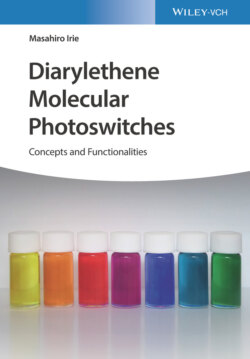Читать книгу Diarylethene Molecular Photoswitches - Masahiro Irie - Страница 10
1 Introduction 1.1 General Introduction
ОглавлениеBiological systems have developed various kinds of photoactive organs to adapt themselves to environmental electromagnetic radiation, sunlight. In biological systems, light is used in two ways as shown in Figure 1.1. In plants, for example, photosynthetic systems have evolved to utilize light as an energy source. Carbohydrates are produced from water and carbon dioxide in plants by using light as an energy source. Another category is the use of light for information access and transmission. Light is used to seek out optimum conditions for their life. Photoresponsive biological systems for vision, phototaxis, and phototropism have evolved to recognize surrounding conditions and to access external information. In the former, photoinduced electron transfer is a key chemical reaction. On the other hand, photoisomerization plays a key role in the latter.
Figure 1.1 The use of light in biological systems.
Photoisomerization is one of the fundamental reactions in photochemistry [1–3]. Trans–cis isomerization, sigmatropic rearrangements, and electrocyclic rearrangements are typical examples. Molecules capable of these reversible photoisomerization reactions are called photochromic molecules or molecular photoswitches [4–10]. The two isomers differ from each other not only in their absorption and fluorescence spectra but also in their geometrical structures, oxidation/reduction potentials, refractive indices, and dielectric constants.
Scheme 1.1 shows typical examples of photoswitchable molecules and when they were discovered. The three upper molecules, azobenzene [11], spirobenzopyran [12], and bridged imidazole dimer [13], belong to T‐type (thermally reversible) molecular photswitches, in which photogenerated right‐side colored isomers are thermally unstable and spontaneously revert back to left‐side colorless isomers in the dark. Azobenzene undergoes a large change in geometrical structure during the photoisomerization reaction from the trans‐ to the cis‐form. The distance between 4 and 4′ carbon atoms (the long axis of the molecule) decreases from 0.90 to 0.55 nm and the dipole moment increases from 0.5 to 3.1 D [14, 15]. A spirobenzopyran derivative, 6‐nitro‐1′,3′,3′‐trimethylspiro[2H‐1‐benzopyran‐2,2′‐indoline], converts from a less polar spiro‐form to a polar merocyanine‐form upon irradiation with UV light. It is reported that the dipole moment of the spiro‐form is 6.2 D, while it increases to 13.9 D in the merocyanine form [16]. The blue color of the merocyanine form disappears in less than an hour even in high‐Tg polymer matrices in the dark at room temperature [17]. A colorless bridged imidazole dimer, 1,8‐TPID‐naphthalene (TPID: dimer of triphenylimidazolyl radicals), turns green in toluene upon irradiation with UV light, and the green color disappears in less than a few seconds after switching off the UV light [18]. The imidazole dimer exhibits extremely quick response.
Scheme 1.1 Molecular photoswitches and years when they were discovered.
The two lower molecules, furylfulgide [19] and diarylethene [20–22], undergo P‐type (thermally irreversible but photochemically reversible) photoswitching reactions. In the P‐type molecular photoswitches, photogenerated right‐side colored isomers are thermally stable and practically never return to the right‐side colorless isomers in the dark at room temperature. Although many molecular photoswitches have been so far reported, P‐type chromophores are very rare. The families, furylfulgides and diarylethenes, are two such rare examples exhibiting P‐type reactivity. The primary difference between furylfulgides and diarylethenes is fatigue resistance. Photoinduced coloration/decoloration cycles of well‐designed diarylethene derivatives can be repeated more than 104 times maintaining adequate photoswitching ability (see Section 3.3), whereas in most cases the corresponding cycles of furylfulgides are limited to less than 102 times.
The instant property changes of photoswitchable molecules by photoirradiation without any additional process lead to their use in various photoresponsive materials and photonic devices. When the bistable molecules are incorporated into materials, the electronic structure changes can be applied to optical memory media and conductance photoswitches, while the geometrical structure changes can be applied to light‐driven actuators and others. Molecular photoswitches used in such applications are required to fulfill following properties.
1 Thermal stability of both isomers
2 Fatigue‐resistance
3 High sensitivity
4 Rapid response
5 Reactivity in the solid state.
Molecular photoswitches belonging to the diarylethene family fulfill the above requirements simultaneously. Diarylethenes are derivatives of stilbene. When the phenyl rings of stilbene are replaced with five‐membered heterocyclic rings, such as thiophene or furan rings, both open‐ and closed‐ring isomers become thermally stable and photoinduced coloration/decoloration cycles can be repeated many times. The best photoswitching performance of well‐designed diarylethenes is summarized as follows.
1 Both isomers are thermally stable: half‐life times at room temperature are as long as 470 000 years at 30 °C.
2 Photoinduced coloration/decoloration can be repeated for more than 104 cycles.
3 The quantum yield of cyclization (coloration) reaction is close to 1 (100%).
4 Response times of both coloration and decoloration reactions are less than 20 ps.
5 Many of diarylethene derivatives undergo photoswitching even in the single crystalline phase.
